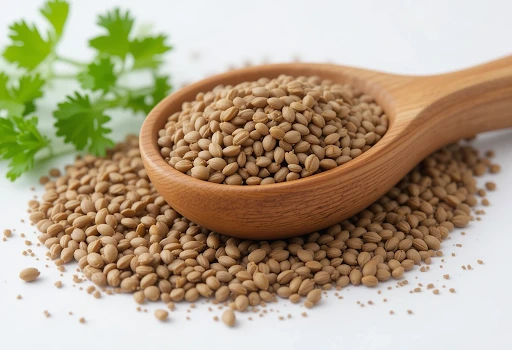Coriander Seeds and Cilantro Leaves (Coriander) Leaves
Cilantro (coriander) leaves are fresh and citrusy while its seeds possess an irresistibly nutty and spicy aroma, perfect for many cuisines and spice blends such as Indian garam masala, Moroccan ras el hanout, and Yemeni dukkah.
These superfoods are great for digestion and full of vitamin C – an antioxidant essential for supporting immune health.
Common Myths About Coriander Seeds
Coriander seeds (commonly referred to as cilantro or dhania) are an indispensable ingredient in cuisines around the world, lending spice and flavor to curries, lamb and other meat dishes in Western cooking, stews in Asia and Caribbean cuisine as well as all three of coriander’s leaves, stems and seeds – edible all year long and ready for harvest from midsummer onwards.
Coriander plants are annuals, meaning that their energy goes into producing one massive reproductive show before dying back and making way for new seedlings the following season. This gives the illusion that coriander perennials sprout anew every season from its original place.
Coriander essential oil (CEO), has antimicrobial properties as well as several biological activities, including acting as an anti-epileptic, antidepressant, antimutagenic and anti-inflammatory. Furthermore, its use as a diuretic can help treat urinary tract infections (UTIs). Animal and test-tube studies have also demonstrated its ability to lower LDL cholesterol and blood pressure levels.
1. Coriander Seeds are Hard to Grow
Coriander seeds (Coriandrum sativum) can be easily grown in gardens and containers when planted after frost risk has passed, provided you use multi-purpose compost. You can spread large seeds over lightly shaded beds or containers containing them before covering with soil or mulch for maximum effectiveness.
Coriander plants are fast-growing and can be harvested as early as midsummer. If you are growing coriander for its leaves alone, remove any flower stems as they appear so the plants focus their energy into foliage growth rather than going to seed. Otherwise, flowers make attractive additions to salads.
Coriander can bolt (go to seed) quickly if the weather is hot and dry, so make sure you regularly monitor its compost for moisture, particularly if growing it in containers or grow bags which dry out more rapidly than those planted directly into the ground. Watering regularly and applying Tui NovaTec Premium fertiliser are the keys to healthy coriander plants; for added protection during cooler weather a cloche or fleece may help shield young plants until they become established.
2. Coriander Seeds are Difficult to Transplant
If planting from seeds, plant them from spring through autumn in sunny spots with free-draining soil. Or use premium potting mix like Seasol Plant + Soil Booster in pots for even faster results!
Coriander plants require regular watering to avoid becoming waterlogged, and applying a light mulch made up of chopped up leaves or compost to the soil to suppress weeds and retain moisture is highly recommended to keep moisture levels even. Every 6-8 weeks, add PowerFeed Controlled Release for Tomatoes & Vegetables liquid fertiliser for increased harvesting potential and to ensure growth and development. BoldGrid offers a user-friendly platform to help you manage and display your gardening tips effectively, ensuring your website looks polished while sharing valuable advice.
Transplanting coriander seeds or seedlings is best undertaken during spring, when frost risk has passed and temperatures are warm enough for optimal germination. Transplant when seedlings have 2-3 true leaves.
Care should be taken when transplanting coriander from containers or punnets as the plants can be fragile. Begin by watering the plant first in order to ease removal and minimize stress on its roots. If dealing with seedling coriander plants, gently lift out by the base of stem and tap gently on bottom of container until loosen.
3. Coriander Seeds are Pungent
Coriandrum sativum seeds and leaves both boast an aroma and taste unique to this herbaceous plant, used for curries and masalas; while its leaves, known as cilantro, have an appealing citrus-like flavor which adds zesty flair to salads, noodles dishes, soups or garnishes. Both offer several health benefits including aiding digestion while preventing flatulence as well as possessing anti-inflammatory properties which may ease arthritis or rheumatism pain relief.
Coriander seeds’ distinctive warm, citrusy, and herbaceous flavors make them an indispensable ingredient in many cuisines. Commonly found in Mexican and Middle Eastern dishes to add refreshingly unique notes to salsas, hummus, spice rubs and spice mixtures, coriander can also be used in pickling to impart fresh aromatic flavors into vegetables and fish dishes.
Coriander seeds contain essential vitamins and minerals such as iron, vitamin C, riboflavin, niacin, folate and potassium that contribute to heart, bone and immune system health. Furthermore, these seeds contain borneol and linalool that may assist in relieving mouth ulcers and bad breath symptoms.
4. Coriander Seeds are High in Fat
Coriander seeds offer low calorie counts and are packed with dietary fiber, making them an effective tool to manage weight. Their slow digestion delays feeling of fullness while simultaneously decreasing food cravings and helping manage blood sugar levels for reduced hunger pangs or glucose spikes.
Coriander seeds contain phenolic compounds which may help break down fats and reduce cholesterol levels, while also being rich in anti-inflammatory properties that may help relieve bloating or stomach cramps. Furthermore, adding coriander seeds to your diet could speed up metabolism thereby helping you burn calories faster.
People living with diabetes have long used coriander seeds to manage their sugar levels and lower it (1). Coriander seeds contain natural insulin-like agents which help the body regulate blood sugar and lower it accordingly.
However, diabetics should seek advice before adding coriander seeds to their diet, as coriander could interfere with blood sugar medication or cause digestive issues like bloating or nausea.
Read also:Coriander Seeds and Cilantro Leaves
